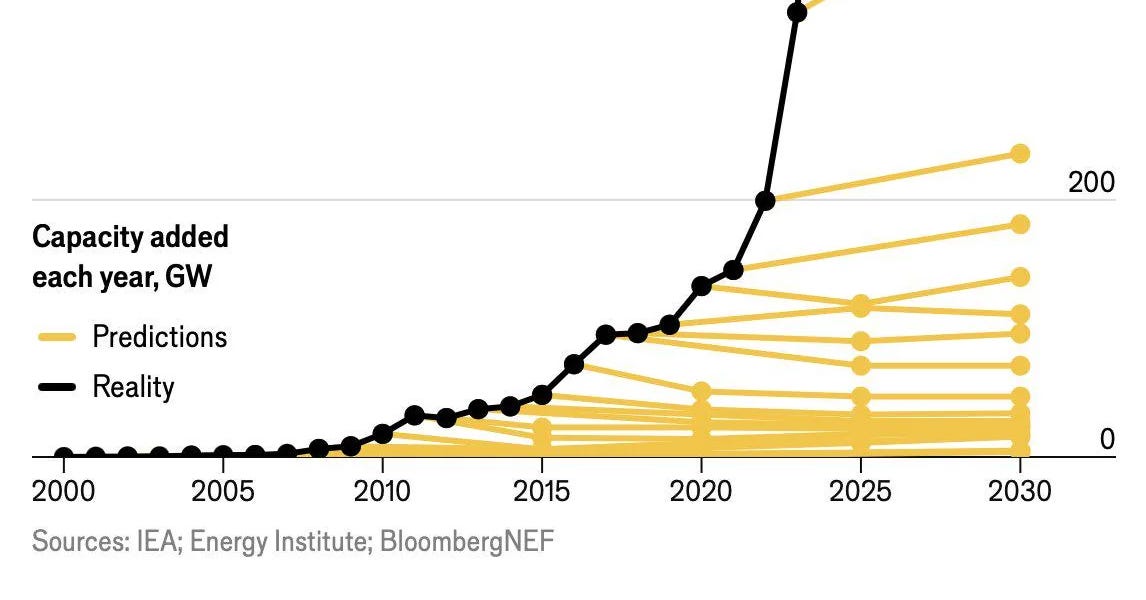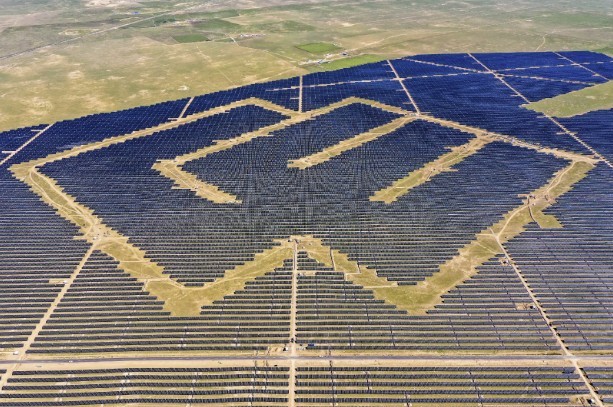- 4 Posts
- 16 Comments

There is a flaw when measuring GDP impacts of energy. The more expensive the energy, the higher the GDP including higher costs of goods and transportation costs and heating. With this measure, you can boost GDP by boosting extortion power with 0 new investment. Just higher energy prices.
The economic value of energy is best measure in mwh “to the tire”, ie after waste energy. The lower the price, the better economic value for consumers which includes manufacturing and other commerce. Jobs come from investment and energy expansion. When clean energy replaces climate terrorism, jobs are created even as climate terrorist revenues and profits fall. There are widespread gains even as privatized losses occur.
The costs of climate change can be separated between widely insured jurisdictions and uninsured developing world. Either way, property values are diminished by drought (farming value especially), and intense wind/flooding storms. We can place an economic cost on deaths caused. In developing world, emigration north becomes a reaction to losing everything and hopelessness.
In developed world, an insurance crisis and associated property devaluation can lead to a leveraged banking crisis. Where rebuilding in a spot is a dumb idea, banking losses follow, even as inland property becomes more desirable. Intense rain events in inland areas (Hurricane Helene as one example, but many areas are being impacted by extreme rain events unrelated to hurricanes) still creates an insurance crisis, as every year seems to spawn a 500 year event somewhere, and 2024 had several such events globally.
These are current unfolding crisis of global warming that will get incrementally worse each year/decade. The risk of Greenland/Antarctica led sea rise, and the march forward towards those events are not good for property values either, as is continued heating of oceans/land to bring more intense storms and droughts.
Technological expenses for surviving are a solution, but still a cost: Indoor farming, lab meat, AC, rebuilding homes on stilts.
War, starvation, genocide is another path to bring high profit from global warming to a select few. If war is needed, then surely those human sustainability hippies can be ignored while we do the important genocide, use up more oil in the process, and sanction the oil from our war opponents so that our friends (for now) can drill for more.
Caring about global warming, and its enormous costs, is only a luxury when you don’t have more important concerns than human sustainability. It is extremely easy to make you have more important concerns.

Nationalizing oil companies in US/west is needed due to their climate terrorist lobbying. Many other oligarchs/industries corrupt rulership, but it is clear that FFs are incompatible with the high cost of US democracy.

 1·7 days ago
1·7 days agoThe economics of batteries are that they must be fully charged and discharged daily to pay off. A 2 day average cycle is double the cost of energy in using them.
In spring and fall we get positive happy headlines that “all electricity was provided by solar/renewables” during 1 hour or so during a day, or that electricity prices went negative. These seasons are low demand with good enough sun. Batteries get let those days/seasons get to 24 hour power from renewables, but then summer heatwaves won’t fill demand even with more sun, winter will not charge up the batteries enough. H2 electrolysis is needed to have enough solar and batteries to cover all those needs, and then use H2 to cover winter supplemental needs. H2 supports not just more solar, but also more batteries. Makes sure batteries can always discharge before the sun comes up.
imagine refueling times is not necessarily going to be critical for all types of commercial use-cases.
Commercial vehicles, need to pay operators for downtime, and downtime is time not earning revenue. it is a bid deal to them.
Aviation struggles with the relatively low energy density in H2.
At $4/gallon diesel/kerosene, a plane will cost 100x in fuel as its purchase costs. We can already produce green H2 at $2/kg compressed. Which is equivalent to $1/gallon gasoline fuel when used in a FC. Redesigning planes, and delta wing for long range specifically, for H2 is worth liquifying the H2 for the weight savings and range over compressed. It’s also that price that can compete well with commercial EV charging.

 2·7 days ago
2·7 days agoI don’t know that processing silicon is a polluting activity. There is heat involved, and some Chinese producers are 100% solar powered for their processing. Though I’m sure bulldozers or shipps/trucks are involved in obtaining sand.
I’m not a fan of any appeals to gatekeep energy use to “just essentials” instead permitting growth that people want, and cleaning up the energy use involved.

 1·7 days ago
1·7 days agoThe difference is that the electrolysis can be done at producer convenience. Sometimes wholesale electricity prices (midday due to high solar penetration) are negative or ultra cheap. Transporting H2, even by truck, can be cheaper than the US typical 8c/kwh electric transmission charge. For many areas, enough solar in winter has 3x more summer production and essentially unusable. A balance of solar and H2 produced in summer, can provide the cheapest necessary energy for winter. An alternative is summer exports with winter imports.
Batteries alone are also subject to curtailment, or not enough charging in winter. H2 can be stored at $1/kwh, where a pipeline is free transmission of withdrawals different from deposit locations. The energy efficiency round trip is less important than the $ efficiency of energy delivery.

 1·7 days ago
1·7 days agoThe expense part gets taken care of with OP’s solar prices. Battery costs help too.

 1·7 days ago
1·7 days agoThe case for an H2 economy is one entirely based on Green H2 made from surplus renewables which are needed most days to have enough renewable energy every day.
That gas companies know how to build pipelines, distribution, and make metered gas sales to customers is a path for them/employees to remain useful without destroying the planet.
Commercial vehicles has legitimate benefits of lower cost from H2 FCs than batteries. Quicker refuel times. Aviation especially benefits from redesigning planes for H2 for the weight savings. Trains/ships need the power/range. Trucks/cars can use the range extension, and could use H2 as removable auxiliary power for extended range.
Those vehicles can also charge the grid, and as hybrids, EVs or grid can be charged from static H2 FCs. For building energy, a FC can provide the usual fraction of domestic hot water from its waste heat. The electric monopoly problem is an opportunity for both producers and consumers to bypass their high rates and fees. Ammonia and fertilizer is traditional use for H2. There needs to be a carbon tax to move away from giant fosil H2 plants powering next door giant ammonia/fertilizer plants.
Hydrogen electrolysis is just one form of electro chemistry. Other fertilizers can be made from simpler versions of the process. It’s not so much that H2 is essential in unlimited quantities, it is that electro chemistry is possible ultra cheaply when there is an abundance of renewables that provides enough energy every day to power their locality. H2 is special as a chemical for being transportable/convertable as mobile or other elecricity/heat.

 2·7 days ago
2·7 days agoHVDC is much more expensive than Hydrogen pipelines, which doubles as storage and transmission, and can provide continent wide resilience, even when local renewables provide much cheaper power when it is available than either long distance electric or H2 power.

 2·7 days ago
2·7 days agothere is some nuclear tech that can use nuclear waste as at least part of it’s fuel
Those are less competitive, and salt reactor attempts have historically caused terminating corrosion problems. The SMR “promise” relies on switching extremely expensive/rare/dangerous plutonium level enriched fuel, that rely on traditional reactors for enrichment, for slightly lower capital costs.

 3·7 days ago
3·7 days agoAnd cheaper solar and batteries permits cheaper Hydrogen which provides unlimited and 100% resilient renewable power, and still cheaper than nuclear.

 3·7 days ago
3·7 days agoBatteries can be containerized in modules, with a turnkey connection that remains mobile. Solar can use those containers as support structure. Hydrogen electrolyzer/fuel cells can also be built in same containers.

 1·7 days ago
1·7 days agoAlso the budget and timeline is always understated, because otherwise government could withdraw funding if they don’t sink a little more cost into the budget every year.

 1·7 days ago
1·7 days agoIt is very poorly implemented. “Builder grade” solar panels in a “smallest compliant” configuration with no concern for architecture to benefit from solar takes place. Builders are intentionally putting the shittiest solar to reduce value of the homes they build so that they can complain about the policy.

 6·7 days ago
6·7 days agoManufacturing photovoltaics takes a huge pile of chemicals that need to be handled properly to not cause any harm to the environment
Source for this? Cadmium is exclusive to 1 US manufacturer.

 391·7 days ago
391·7 days agoWhen panels were 30c/watt, projects at $1/watt in EU and US happened. 70c/watt was spent on labour, copper, support structures, and grid connection equipment. All of those can be locally produced, with possible exception of last item.
At 6c/watt, that is over 90% of power projects are local economy boosting instead of 70%. It provides cheaper energy that is useful for industrialization and cost of living benefits too. US tariffs on solar are entirely about protecting oil/gas extortion power instead of a $10B solar production industry that needs fairly expensive support.
Solar imports does not cause energy dependence. You have power for 30+ years with no reliance on continuous fuel supplies. Shoes and apparel is a $450B industry in US. You need new supplies every year, and it makes much more sense to secure supply in that industry for war on the world purposes.





Over 22% share from plug in vehicles overall. I’d be surprised if Hybrid category excludes plug in hybrids, dropping it to 25%. I’d be extremely surprised if people wouldn’t prefer a $1000 option for plug in for whatever non plugin hybrids they are buying. OTOH, there is a complete BS category of hybrid. F150 Hybrid in US has a battery size that is equivalent to a lead acid non hybrid, as an example.
EU just had an auto show for next year’s EV models which look great, and so would naturally stop intending EV buyers from buying these next months instead of waiting a bit. Maybe more Chinese competition soon. Geopolitical fuckery makes EU life difficult to forecast.
EU EVs still doing much better than US is the headline that could have been chosen.